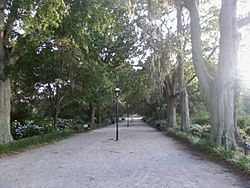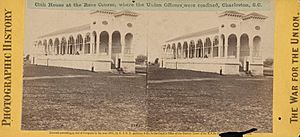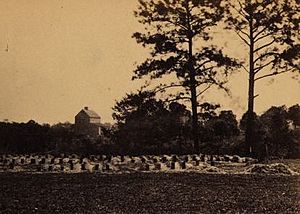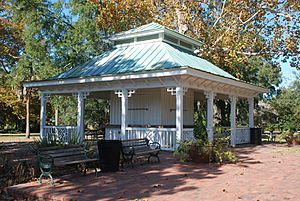Hampton Park (Charleston) facts for kids
Quick facts for kids Hampton Park |
|
|---|---|
 |
|
| Area | 60 acres (24 ha) |
| Created | 1906 |
| Parking | 40 |
Hampton Park is a large public park in Charleston, South Carolina, United States. It covers about 60 acres (240,000 m2), making it the biggest park on the Charleston peninsula. The park is surrounded by different neighborhoods like The Citadel and Hampton Park Terrace. It is named after Wade Hampton III, a general who fought for the Confederate States of America during the American Civil War. After the war, he became a supporter of the Lost Cause of the Confederacy movement and later served as the governor of South Carolina.
Contents
Park History
From Plantation to Park
The land that is now Hampton Park was once part of a large farm called The Grove or Orange Grove Plantation. This farm was owned by John Gibbes in 1769, long before it became a park.
Horse Racing Days
In 1835, a group called the South Carolina Jockey Club bought part of the plantation. They built a horse racing track there called the Washington Race Course. Every February, thousands of people would come to watch the horse races from a fancy grandstand. Today, Mary Murray Drive, a 1-mile (1.6 km) road that goes around Hampton Park, follows almost the exact path of the old race track.
The American Civil War caused a big decline in horse racing. Many horses were lost, and the economy struggled during the Reconstruction Era after the war. Because of this, the South Carolina Jockey Club eventually closed down in 1899.
A Place of Remembrance
During the final days of the Civil War, the area was used as a camp for prisoners of war. Sadly, more than two hundred Union soldiers died there and were buried in a mass grave.
After the war ended in 1865, thousands of newly freed African Americans in Charleston held a special event at the former race course. On May 1, 1865, they honored the fallen Union soldiers. About twenty-eight black workers had already properly re-buried the soldiers and built a fence around the cemetery. They even put up an archway that said "Martyrs of the Race Course."
On that day, a huge parade took place. It started with three thousand black schoolchildren carrying roses and singing. They were followed by hundreds of black women with flowers, and then black men marching. Union soldiers, including the famous 54th Massachusetts Volunteer Infantry, also joined. People gathered at the cemetery, where a children's choir sang patriotic songs and ministers read from the Bible. After the ceremony, people enjoyed picnics and watched soldiers drill. Many historians believe this event was one of the earliest celebrations that led to what we now call Memorial Day.
By 1871, the cemetery was not well-maintained. The soldiers' remains were later moved to other national cemeteries in Beaufort and Florence.
After the Jockey Club closed, the land was used for farming for a while. In 1900, the remaining parts of the race track were removed.
The Big Exposition
At the start of the 20th century, Charleston hosted a large trade show called the South Carolina Inter-State and West Indian Exposition. This event took place on the land that included the old race course. It opened on December 1, 1901, and attracted over 674,000 visitors. Even President Theodore Roosevelt visited the exposition on April 9, 1902. However, the exposition did not make money and closed on May 31, 1902.
Hampton Park Today
After the exposition, the city of Charleston bought part of the land to create a public park. The park was named Hampton Park, honoring General Wade Hampton III. The bandstand from the exposition was saved and moved to the east side of the park. Also, a building that was once a tea house during the exposition is now used as the city's Parks Department offices.
The city hired a famous landscaping company, Olmsted, Olmsted & Elliott, to design the park. John Charles Olmsted, the adopted son of Frederick Law Olmsted (who designed Central Park in New York City), created a plan for Hampton Park in 1906.
The Park's Zoo
In the mid-20th century, Hampton Park even had a zoo! It opened in 1932, and an aviary (a large bird enclosure) was added a few years later. Most of the animals, including a lion, were donated or bred at the zoo. By the mid-1960s, the zoo started to decline. It finally closed in 1975, and most of its animals were moved to Charles Towne Landing, a new state park.
Modern Renovations
In the early 1980s, the city began to improve the park. They worked on the landscaping, reduced crime, and added a small snack stand.
The improved park reopened in June 1984.
Today, Hampton Park is a popular spot for people who enjoy walking, jogging, and cycling on the 1-mile (1.6 km) road around its edge. It hosts events like the MOJA Festival, as well as many weddings and other special gatherings.
In 2015, the Charleston Parks Conservancy, a non-profit group, proposed plans to make parts of the park even better. These plans included restoring the old building at 30 Mary Murray Blvd. and turning nearby stables into a place for special events. The snack stand was also renovated in 2019 and is now known as the "Rose Pavilion," a public gathering spot.




